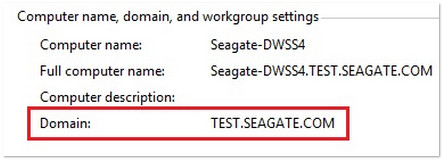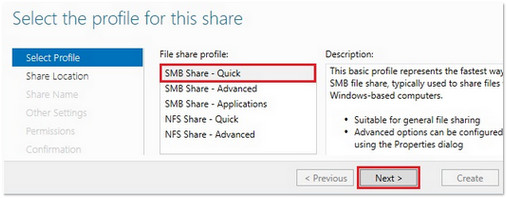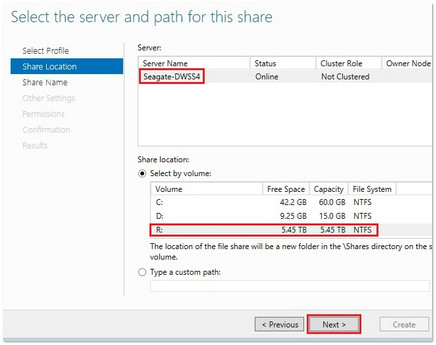Please follow this procedure to join the Business Storage Windows Server NAS to an Active Directory domain and assign domain users to shares:
Set a Static DNS server address
By default, the Windows Server NAS is set to automatically obtain an IP address and a DNS server address. Seagate recommends you set a static IP and DNS server address manually.
In this example we will only set a static DNS server address.
- Open the Control Panel.
- Select View network status and tasks or Network and Sharing Center.
- Select Ethernet.
- Select Properties.
- Select IPv4, then Properties.
- Select Use the following DNS server addresses.
- Enter the Domain Controller / DNS Server's IP Address, then click OK.

Join the Windows Server NAS to a Domain
- Open the Start menu.
( Press the Windows key ( ) + D to arrive at the desktop first.)
) + D to arrive at the desktop first.) - Open File Explorer (
 ).
). - Right-click on Computer and select Properties.
- Select Change settings Under Domain, and workgroup settings.

- Select Change...
- Under Member of, select Domain, then enter the Fully Qualified Domain Name (FQDN), then click OK.

- Enter the user name and password of the Domain Administrator that has permissions to join the domain, then click OK.

- Click OK at the Welcome to the domain prompt. Click OK again.
- Restart the NAS to apply changes.
- Upon restarting, System Properties displays the Windows NAS on the domain.

Create a Share and Assign a Domain User to the Share
- Click on the Server Manager icon (
 ) on the bottom left of the Windows screen.
) on the bottom left of the Windows screen. - Select File and Storage Services.
- Select Shares , then To create a file share, start the New Share Wizard.

- Select SMB Share - Quick, then Next.

- Select a Server and Share Location.
- For the Share location, choose select by volume.
- Select the drive letter/volume where the share will be created.
 It is not recommended to choose the C: drive to store the share.
It is not recommended to choose the C: drive to store the share.
In this example we chose a RAID volume, drive letter R:.
Select Next.

- Specify the Share Name and Description , then click Next.

- Configure Share settings, then click Next.
Assign Permissions and Domain Users to the Share
- Select Customize permissions.
- In Advanced Security Settings for the Share, click the Share tab.
- Select Allow Everyone Full Control, then select Remove, then select Apply.

- Add a specific user by selecting Add.

- Click Select a principal.
Select a Domain User
There are two ways to select a domain user.
- Under Enter the object name to select, enter the name of a Domain User and select Check Names.
You may be prompted for the Domain Controller Administrator login credentials. - Select Advanced , then Find Now. A list of Domain Users will populate. Click the correct User, then OK.
You may be prompted for the Domain Controller Administrator login credentials.
The following screenshot is for option 2:

The Domain User now listed as an object. Click OK.

Set Permissions for the User
- By default, permissions are set to Read and Execute only.
Check the Full Control and Change options, then click OK.

- Select Apply, then OK.
- On the Specify permissions window to control access, select Next.
- Confirm that the settings are correct, then click Create.
- Note that the Share was created successfully.
- Click Close.





